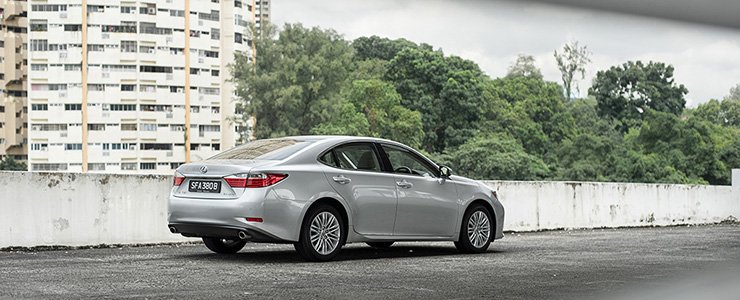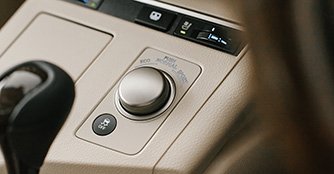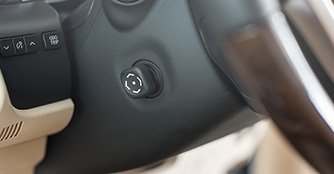Lexus ES250 2.5 Luxury (A) Review
18 Dec 2013|33,388 views
Designed to a familiar formula of ample mid-sized proportions, solid reliability, a comfy ride and a luxurious ambience, the Lexus ES has always been one of those cars where its loyal owner simply trades in one for another when it's time to get a new car.
Introduced in 1989, the original Lexus ES was one of two vehicles in Lexus' debut lineup, the other car being the flagship LS. Five generations through, each one of them were based on the Toyota Camry of their times.
For the sixth instalment, in an effort to imbue it with a quieter ride, better handling and more spaciousness, Lexus engineers chose the Toyota Avalon and its longer wheelbase to provide the model's platform.
The new ES may slot in just below the IS range but spatially it offers accommodation closer to that of the GS - think of it as the spacious and comfortable alternative to the more dynamically focused IS and GS ranges.

Up close and Personal
The exterior styling of the new ES is an evolution of the previous car. Lexus has adopted some styling cues from the GS, but the ES's silhouette is instantly familiar. The ES is also the latest model to wear the signature Lexus face - the dramatically sculpted spindle grille.
 |
Arrowhead daytime running lights up front reference the range's sportier models, while dual exhaust outlets provide the otherwise restrained rear end with some visual spice. Overall, it comes across as an elegant and luxurious barge.
The first thing that strikes you when you fold yourself into the cabin is space. Unlike some other models in Lexus' range, the adoption of a front-wheel drive configuration removes the need for a transmission tunnel, which further liberates space in the rear for comfort and a feeling of openness.
And speaking of space, a luggage capacity of 490 litres is more than enough to haul a couple of golf bags.
The interior of the new Lexus ES is also a far more modern and stylish environment than that of past generations. The new centre console marries traditional techniques with craftsmanship for a high-quality finish, including a hand-stitched dash panel and a high tech self-illuminating LED analogue clock.
 |
The Drive
Under the bonnet of the new ES is a 2.5-litre engine that produces 184bhp and 235Nm of torque.
Considering that the ES weighs in around 1,600kg, these figures mean that the car takes about 10 seconds to hit 100km/h from zero. Nonetheless, the ES is by no means a performance car, and we found the drivetrain to be quite adequate for the size of the car.

The six-speed ECT automatic gearbox paired with the engine also prefers a sedate driving style. It shifts smoothly during normal driving conditions but seems a tad tardy when driven a little more enthusiastically. However, considering the fact that comfort triumphs sportiness in the new ES, few will want to drive it that way.
On the go, the cabin of the ES remains remarkably silent, mostly devoid of wind, road or engine noise. While the ride is obviously and very effectively tuned for comfort, the ES still manages to be reasonably engaging through bends, though a little body roll was experienced. That said, the ES still provides a pliant and cushy ride, soaking up those bumps and ruts without much difficulty.
Conclusion
The Lexus ES should continue to please its loyal customer base while being updated enough to remain relevant in its competitive segment.
For those interested in a mid-sized luxury sedan, the ES' focus on comfort, space and value-for-money over outright dynamic ability makes it a car that is worth looking at.
Designed to a familiar formula of ample mid-sized proportions, solid reliability, a comfy ride and a luxurious ambience, the Lexus ES has always been one of those cars where its loyal owner simply trades in one for another when it's time to get a new car.
Introduced in 1989, the original Lexus ES was one of two vehicles in Lexus' debut lineup, the other car being the flagship LS. Five generations through, each one of them were based on the Toyota Camry of their times.
For the sixth instalment, in an effort to imbue it with a quieter ride, better handling and more spaciousness, Lexus engineers chose the Toyota Avalon and its longer wheelbase to provide the model's platform.
The new ES may slot in just below the IS range but spatially it offers accommodation closer to that of the GS - think of it as the spacious and comfortable alternative to the more dynamically focused IS and GS ranges.
Up close and Personal
The exterior styling of the new ES is an evolution of the previous car. Lexus has adopted some styling cues from the GS, but the ES's silhouette is instantly familiar. The ES is also the latest model to wear the signature Lexus face - the dramatically sculpted spindle grille.
Arrowhead daytime running lights up front reference the range's sportier models, while dual exhaust outlets provide the otherwise restrained rear end with some visual spice. Overall, it comes across as an elegant and luxurious barge.
The first thing that strikes you when you fold yourself into the cabin is space. Unlike some other models in Lexus' range, the adoption of a front-wheel drive configuration removes the need for a transmission tunnel, which further liberates space in the rear for comfort and a feeling of openness.
And speaking of space, a luggage capacity of 490 litres is more than enough to haul a couple of golf bags.
The interior of the new Lexus ES is also a far more modern and stylish environment than that of past generations. The new centre console marries traditional techniques with craftsmanship for a high-quality finish, including a hand-stitched dash panel and a high tech self-illuminating LED analogue clock.
The Drive
Under the bonnet of the new ES is a 2.5-litre engine that produces 184bhp and 235Nm of torque.
Considering that the ES weighs in around 1,600kg, these figures mean that the car takes about 10 seconds to hit 100km/h from zero. Nonetheless, the ES is by no means a performance car, and we found the drivetrain to be quite adequate for the size of the car.
The six-speed ECT automatic gearbox paired with the engine also prefers a sedate driving style. It shifts smoothly during normal driving conditions but seems a tad tardy when driven a little more enthusiastically. However, considering the fact that comfort triumphs sportiness in the new ES, few will want to drive it that way.
On the go, the cabin of the ES remains remarkably silent, mostly devoid of wind, road or engine noise. While the ride is obviously and very effectively tuned for comfort, the ES still manages to be reasonably engaging through bends, though a little body roll was experienced. That said, the ES still provides a pliant and cushy ride, soaking up those bumps and ruts without much difficulty.
Conclusion
The Lexus ES should continue to please its loyal customer base while being updated enough to remain relevant in its competitive segment.
For those interested in a mid-sized luxury sedan, the ES' focus on comfort, space and value-for-money over outright dynamic ability makes it a car that is worth looking at.
Also read our comparison article on:
Lexus ES250 2.5 Luxury (A) vs Volvo S80 T5 Drive-E (A)Car Information
Lexus ES 250 2.5 Luxury (A)
CAT B|Petrol|12.5km/L
Horsepower
135kW (181 bhp)
Torque
235 Nm
Acceleration
9.8sec (0-100km /hr)
This model is no longer being sold by local distributor
All Used Lexus ES 250Thank You For Your Subscription.









































